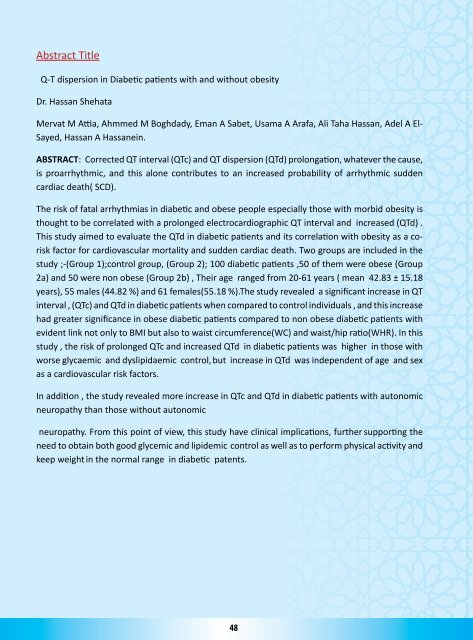Download Booklet - Diabetes in Asia Study Group
Download Booklet - Diabetes in Asia Study Group
Download Booklet - Diabetes in Asia Study Group
Create successful ePaper yourself
Turn your PDF publications into a flip-book with our unique Google optimized e-Paper software.
Abstract title<br />
Q-t dispersion <strong>in</strong> Diabetic patients with and without obesity<br />
Dr. Hassan Shehata<br />
Mervat M attia, ahmmed M boghdady, eman a sabet, usama a arafa, ali taha hassan, adel a elsayed,<br />
hassan a hassane<strong>in</strong>.<br />
ABSTRACT: Corrected Qt <strong>in</strong>terval (Qtc) and Qt dispersion (Qtd) prolongation, whatever the cause,<br />
is proarrhythmic, and this alone contributes to an <strong>in</strong>creased probability of arrhythmic sudden<br />
cardiac death( sCD).<br />
the risk of fatal arrhythmias <strong>in</strong> diabetic and obese people especially those with morbid obesity is<br />
thought to be correlated with a prolonged electrocardiographic Qt <strong>in</strong>terval and <strong>in</strong>creased (Qtd) .<br />
this study aimed to evaluate the Qtd <strong>in</strong> diabetic patients and its correlation with obesity as a corisk<br />
factor for cardiovascular mortality and sudden cardiac death. two groups are <strong>in</strong>cluded <strong>in</strong> the<br />
study ;-(<strong>Group</strong> 1);control group, (<strong>Group</strong> 2); 100 diabetic patients ,50 of them were obese (<strong>Group</strong><br />
2a) and 50 were non obese (<strong>Group</strong> 2b) , their age ranged from 20-61 years ( mean 42.83 ± 15.18<br />
years), 55 males (44.82 %) and 61 females(55.18 %).the study revealed a significant <strong>in</strong>crease <strong>in</strong> Qt<br />
<strong>in</strong>terval , (Qtc) and Qtd <strong>in</strong> diabetic patients when compared to control <strong>in</strong>dividuals , and this <strong>in</strong>crease<br />
had greater significance <strong>in</strong> obese diabetic patients compared to non obese diabetic patients with<br />
evident l<strong>in</strong>k not only to bMi but also to waist circumference(WC) and waist/hip ratio(Whr). <strong>in</strong> this<br />
study , the risk of prolonged Qtc and <strong>in</strong>creased Qtd <strong>in</strong> diabetic patients was higher <strong>in</strong> those with<br />
worse glycaemic and dyslipidaemic control, but <strong>in</strong>crease <strong>in</strong> Qtd was <strong>in</strong>dependent of age and sex<br />
as a cardiovascular risk factors.<br />
<strong>in</strong> addition , the study revealed more <strong>in</strong>crease <strong>in</strong> Qtc and Qtd <strong>in</strong> diabetic patients with autonomic<br />
neuropathy than those without autonomic<br />
neuropathy. from this po<strong>in</strong>t of view, this study have cl<strong>in</strong>ical implications, further support<strong>in</strong>g the<br />
need to obta<strong>in</strong> both good glycemic and lipidemic control as well as to perform physical activity and<br />
keep weight <strong>in</strong> the normal range <strong>in</strong> diabetic patents.<br />
48


